The subject of dosing phytoplankton in a marine aquarium is a popular debate in online forums. Generally, you find advocates favoring dosing phytoplankton arguing against those who believe the potential risks outweigh the benefits. To make sure you get a balanced opinion, I’ll tackle both sides of the coin.
Table of Contents: Dosing Phytoplankton in a Marine Aquarium
- What are Phytoplankton?
- Arguments For and Against Dosing Phytoplankton
- Do Corals Need Phytoplankton in Their Diets?
- Two Common Approaches to Dosing Phytoplankton in a Marine Aquarium
- Comparison of Dosing Phytoplankton Methods
- How to Grow Phytoplankton Cultures at Home
- How to Store Phytoplankton
- For More Information
What are Phytoplankton?
Phytoplankton (also called microalgae) are small photosynthetic organisms that make up the bottom of the aquatic food chain. Drifting along ocean currents, phytoplankton convert light energy from the sun and carbon dioxide into a life-sustaining sugar known as glucose. The name phytoplankton comes from Greek words for “plant drifters” (to further characterize their floating plant life). Like terrestrial plants, phytoplankton utilize photosynthesis.
Phytoplankton are considered primary producers in the food web. This means they make their own food, while many other organisms depend on them as THEIR food.

Arguments For and Against Dosing Phytoplankton in a Marine Aquarium
So why do you see phytoplankton pop up on saltwater forms all the time? It’s due to arguments hobbyists have regarding the necessity (or health) of dosing phytoplankton into their aquariums. And, as with most friendly debates, you’ll find sound arguments on both sides. In the interest of fairness, let’s take a look at both sides to make sure you understand where everyone’s coming from (and then I’ll tell you where I stand on the issue).
In Favor of Dosing Phytoplankton
On natural coral reefs, phytoplankton are an abundant food source for many bivalves, soft corals, sponges, and zooplankton (such as copepods). In-home marine aquariums, however, phytoplankton generally don’t make an appearance. Without the natural supply from the ocean, you don’t see these microscopic plants.
Those aquarists in favor of dosing phytoplankton attempt to provide this natural food source to the invertebrates in their tanks. And their argument for dosing phytoplankton breaks down to two principles:
- Phytoplankton are natural food for many filter-feeding invertebrates
- Dosing phytoplankton provides a nutritional boost for the clams, filter-feeding corals, and other beneficial invertebrates like copepods in their marine aquarium
Against Dosing Phytoplankton
Then you have aquarists opposed to dosing phytoplankton in a marine aquarium. Their arguments boil down to two principles, as well:
- Many of the coral and invertebrate species in a marine aquarium don’t feed directly on phytoplankton. This means a waste of time and money.
- Dosing phytoplankton adds phosphates, nitrates, and silicates. By doing so, you can actually cause water parameters to deteriorate in an otherwise healthy aquarium.
Do Corals Need Phytoplankton in Their Diets?
Whether or not corals need phytoplankton in their diet features prominently in those dosing debates. You’ll find arguments on both sides. But who has the right answers?
Many soft coral species depend on phytoplankton for a significant percentage of their nutrition. Scientists working with octocorals (soft corals) noted them feeding on the microalgae. And it’s documented in Dendronephthya, Isochrysis, and Tetraselmis.
The jury appears to still be out on stony corals, by comparison. According to Eric Borneman, multiple research studies on stony corals have produced conflicting results. One study reported that Acropora, Montipora, Porites, and other stony corals ingest (or at least clear) phytoplankton from the water. Another suggested that only Astrangia and Porites ingest phytoplankton.
While not every species of coral feeds on phytoplankton, it appears to be a beneficial food source for many species. Phytoplankton are also a major food source for tiny invertebrates like copepods. That means dosing phytoplankton may provide a secondary benefit to predatory corals and fish in your aquarium.
The decision about whether or not to dose phytoplankton in your aquarium, therefore, is a personal decision balancing the relative benefits compared with the cost.
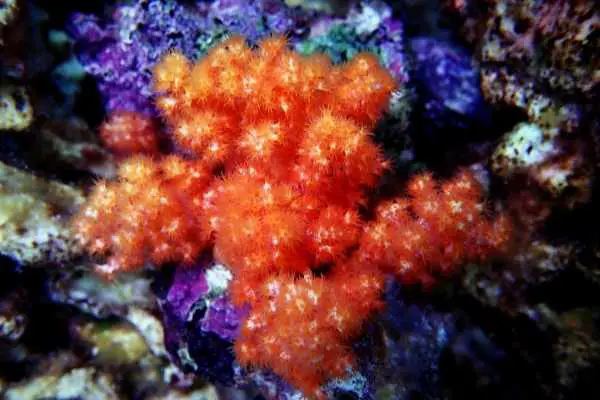
Two Common Approaches to Dosing Phytoplankton in a Marine Aquarium
If you DO choose to dose phytoplankton in your marine aquarium, there are two common ways of doing so: direct (or manual) and indirect (or automated). As you might expect, each comes with advantages and disadvantages. The method you choose for dosing phytoplankton in your marine aquarium is a personal decision you have to make. It’s based on your style and beliefs about the benefits of the phytoplankton to the inhabitants in your tank and the level of involvement you want to have in feeding those organisms. If you’re unsure which method will be right for you, consider alternating between the two.
And, of course, you’ll want to take a look at the equipment (and subsequent cost) to aid in the decision.
Dosing Equipment
For Direct/Manual Dosing
If you’re starting out with dosing phytoplankton, the direct or manual method requires minimal equipment. It’s a nice way to get your feet (well, fingers) wet and decide if you think your corals and other invertebrates might benefit from the process. You can always move on to the indirect method down the road. But, to begin with, you’ll want to invest in the following to get started:
- A bottle of Phytoplankton
An eyedropper, turkey baster, or Julians Thing
 For Indirect/Automated Dosing
For Indirect/Automated Dosing
Once you’re ready to graduate to the indirect or automated method, you’ll need to invest a little more into your budget. However, you’re not increasing the amount of equipment (not really). Dosing phytoplankton ISN’T complicated. The indirect method just takes the automation off your hands.
- Reef dosing pump. You have the option to select a single dosing pump or a multi-pump unit. These range from $100-$500, depending on the number of pumps and features.
- Tubing
- Bottle or reservoir
As you can see from the equipment lists, neither goes over-the-top in terms of complication. I’ve seen mentions of connecting single-unit pumps with electric on/off timers to program an analog pump or put in a fail-safe. It’s handy to have but beyond the scope of the bare basics.
Direct/Manual Dosing
Direct dosing phytoplankton is the technique used when you aim a tiny burst of phytoplankton directly towards the extended polyps of your coral or clams. Using your eyedropper, turkey baster, or pipette, extract a small amount of phytoplankton from the bottle. Keep in mind that a little goes a long way. You only need enough to feed your intended “target.” The next steps are fairly straightforward:
- Slowly move the tip of the dropper next to the coral or clam
- Gently squeeze the bulb to carefully release the phytoplankton contents
- Repeat this step for every coral you intend to feed
The advantage of direct dosing phytoplankton is that you only use a small amount since you’re target-feeding your coral. This keeps costs and the risk of deteriorating water quality low.
The disadvantage of direct dosing is it’s time and labor-intensive (relative to indirect dosing). And the benefits to copepods and the other tiny invertebrates in your live rock and sand are minimal.
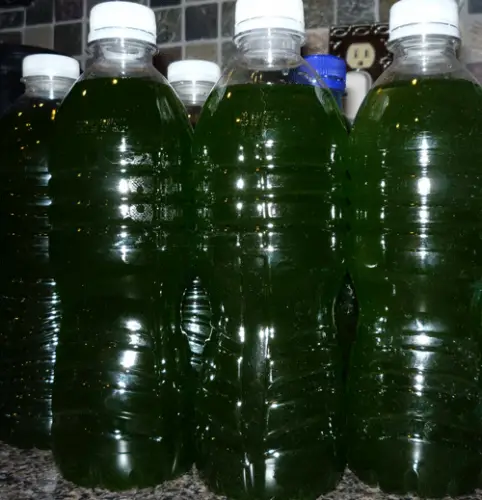
Indirect/Automatic Dosing
Indirect dosing phytoplankton, by comparison, is the technique used when you add the phytoplankton to the water column without targeting a specific coral or invertebrate. While the overall volume of phytoplankton dosed remains small (compared to the tank volume), the dose administered is much larger than with direct dosing. This is because the concentration of phytoplankton gets diluted by the water volume of your aquarium.
If your protein skimmer is left on while you dose phytoplankton for your corals, it will skim the phytoplankton out of your aquarium. That defeats the purpose of setting up your system. So it’s best to turn off your protein skimmer before dosing phytoplankton with the automatic system. Just remember to turn your skimmer back ON when you finish, or you’ll have bigger problems than you bargained for.
Comparison of Dosing Phytoplankton Methods
Still feel uncertain on which dosing phytoplankton method to choose? Let’s break the two down and explore their individual advantages and disadvantages for you. And, remember, you can always alternate between the two to create a healthy feeding environment for your invertebrates. The ocean’s NOT a constant place. So varied diets will simulate that natural state without a problem.
Direct/Manual Dosing Phytoplankton
If you do not grow your own phytoplankton or if you purchase commercial products infrequently, manual dosing will probably work best for your situation. You can go for an “indirect direct” method, making the task as simple as measuring a few capfuls out and pouring it indiscriminately into your tank. Or you can focus on feeding specific corals or clams with an eye-dropper, turkey baster, pipette, or other tools to help you disperse the phytoplankton right where you want it.
Advantages of Direct/Manual Dosing
Manual or direct dosing phytoplankton brings plenty of opportunities for a marine aquarium:
- As long as you have hands (or a substitute), you can dose phytoplankton
- No added cost or technical complexity from your dosing equipment
- You never have to worry about pump failure
Disadvantages of Direct/Manual Dosing
Of course, on the flip side, you have some things to worry about with the direct dosing phytoplankton method:
- Unless you schedule a routine, you may find it difficult to dose phytoplankton with any consistency
- The task of manual dosing can turn into a chore
- Opportunity and risk for human error are very high:
- Leaving the phytoplankton out overnight, causing the bottle to spoil
- Spilling the bottle
- Accidentally overdosing your tank
There is no guarantee you will do any of these things, of course. But the more often you manually dose, the more opportunities you have for something to go wrong. You want to make sure you have these warnings tagged in the back of your mind when you go with this method.
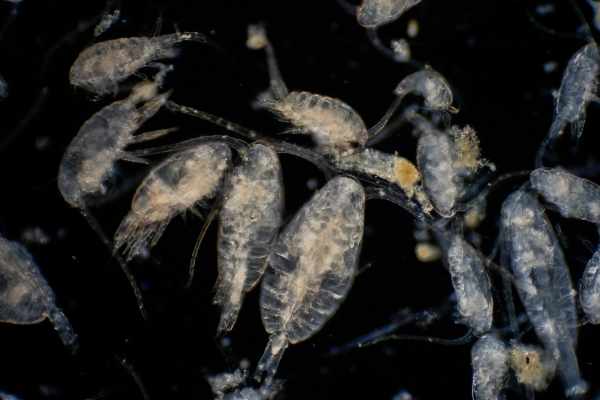
Indirect/Automated Dosing Phytoplankton
If you are a little more tech-savvy, have a slightly bigger budget, or value consistency for your saltwater aquarium, automated dosing phytoplankton may be the best option for you. The basic principle here is “set it and forget it.”
You create a reservoir (a fancy word for a container with the phytoplankton you want to dose), connect some tubing, and add a pump. Then all you need to do is program the pump to slowly, steadily drip phytoplankton into your aquarium until the reservoir empties. The only work involved? Setting up the drip, refilling the reservoir, and performing maintenance (if needed) on the pump.
Advantages of Indirect/Automated Dosing Phytoplankton
Obviously, the “simple” route sounds best. And you have some nice advantages when you choose to go with indirect dosing phytoplankton for your feeding method:
- Maintaining consistent levels of phytoplankton works better for your aquarium than the ups and downs associated with manual dosing
- Once you setup your system, the work involved is minimal
- You eliminate a significant opportunity for human error by automating your system
Disadvantages of Indirect/Automated Dosing Phytoplankton
Once again, though, you need to think about the other side of the coin. You’re using automation for indirect dosing phytoplankton. And that means you have some challenges ahead:
- Setting up an automated system adds complexity and cost to your aquarium
- Pumps and hoses may fail eventually, causing a mess when
How to Grow Phytoplankton Cultures at Home
Perhaps the best place to get fresh phytoplankton to dose in your marine aquarium is to grow your own. It’s easy to do and inexpensive, requiring only the equipment and salt mix you probably have around your house anyway (assuming you have an established marine aquarium).
A straightforward setup can get you started. Phytoplankton require light, fertilizer, carbon dioxide, and oxygen to grow. (Except for the fertilizer, the rest comes free) Once you start growing the phytoplankton at home, you can harvest each bottle about once a week.
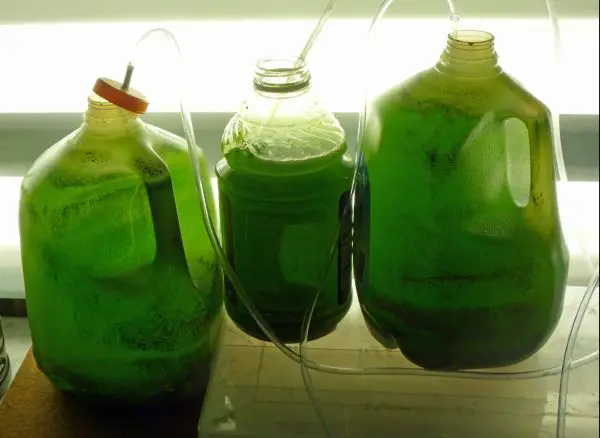
In addition to a nutritional supplement for the corals, clams, and other invertebrates in your marine aquarium, you can use phytoplankton cultures as the base for other home cultures, including rotifers and brine shrimp. Phytoplankton is also typically a necessary step in breeding saltwater fish since it’s a required food source for the rotifers and brine shrimp you feed the newly hatched larvae.
How to Store Phytoplankton
Phytoplankton cultures you intend to feed to your marine aquarium are generally best kept in the refrigerator. While the cultures themselves grow at an aquaculture facility (or in your house) at room temperature, that thriving phytoplankton culture grows at a less concentrated level than the culture in the bottle you bought at your local fish store. If the bottle warms up to room temperature, the phytoplankton will die and foul the water in the bottle.
Obviously, that means if your phytoplankton culture smells spoiled, it probably is. Dispose of it and start over with a fresh bottle. For what it’s worth, this is the single biggest hassle I’ve encountered with dosing phytoplankton. The chore of placing the bottle BACK in the refrigerator when finished is easy to forget (and it brings a TON of regret).
Another consideration when storing phytoplankton in your refrigerator is that the phytoplankton settles to the bottom of the bottle. If the tiny cells stuck at the bottom of the bottle remain there too long, they die. When they die, they (you get it) foul the water, causing EVERYTHING to spoil. Make sure you shake up your phytoplankton culture every few days to keep the phytoplankton suspended rather than layered throughout the bottle.
For More Information
If you’re interested in learning more about the benefits of adding phyto to your tank, check out the Phytoplankton feeding trials. This study (sponsored by a phyto manufacturer) shows some interesting data supporting a boost in growth seen when phytoplankton get added to aquariums.
If you’re still on the fence about the dosing phytoplankton debate, not to worry. It’s probably going to continue to dominate forum threads for the foreseeable future. But you can get some additional insight with this handy YouTube video:
Written by Albert B. Ulrich III

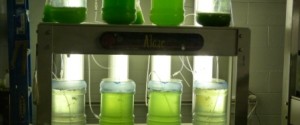
Leave a Reply